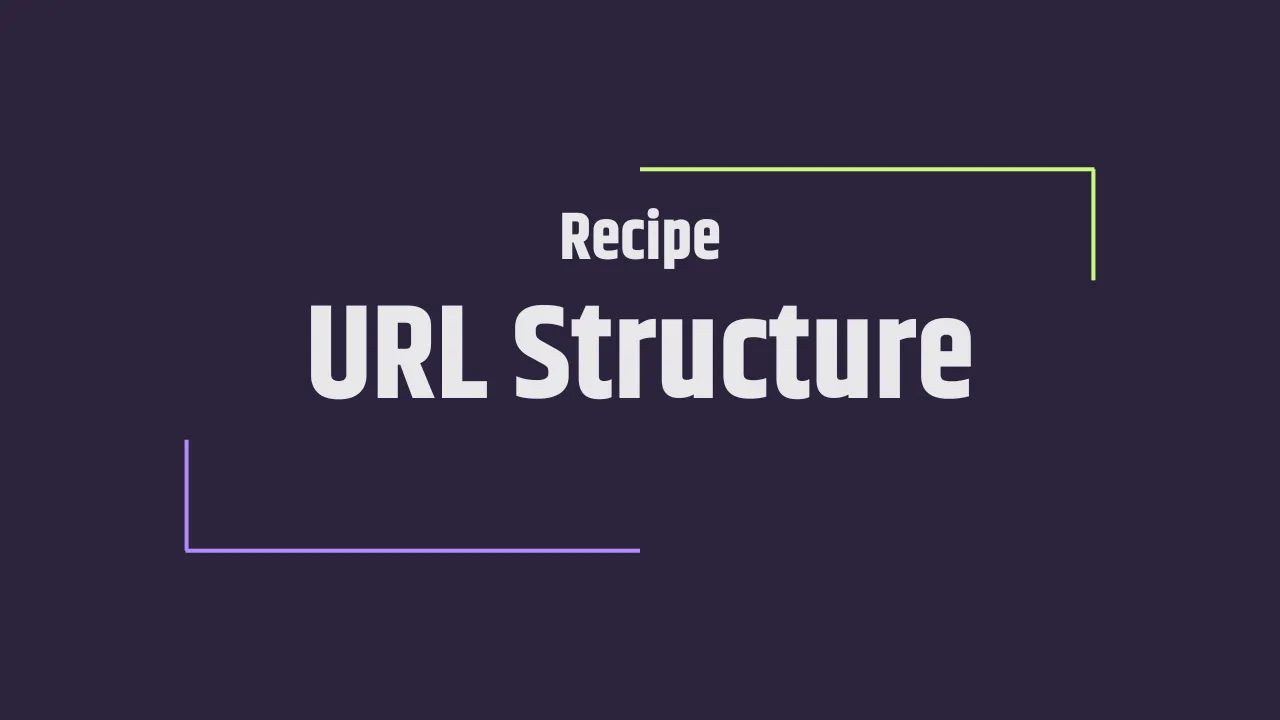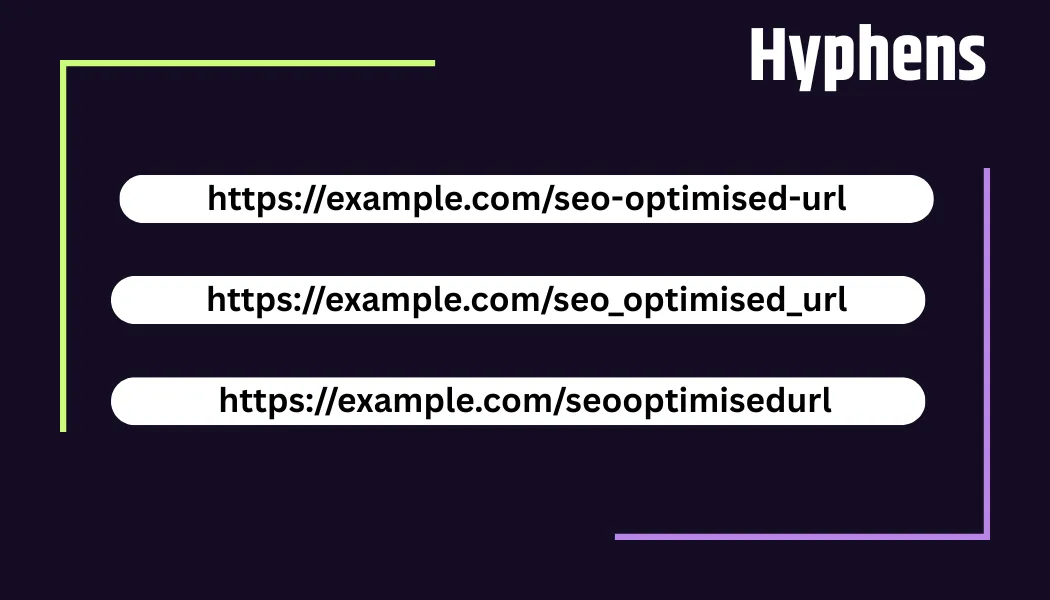SEO Optimized URL Structure

When creating your SEO-friendly URLs, it's important to have the right ingredients. Think of each element here as a building block for your website's usability and visibility in search engines.
You'll want a secure and credible domain name with a .com or another trusted TLD (top-level domain). A site that uses HTTPS, as this secures data and is a confirmed ranking signal. And also a clear keyword list - having these will aid search engines and users to better understand what your pages are about.
An intuitive URL structure in your CMS, such as WordPress, Webflow, or Shopify, will make managing URLs easier. Don't forget canonical tags to prevent duplicate content issues, and ensure you're using hyphens to separate words. Finally, access to tools like Google Search Console lets you monitor, submit, and fix your URL performance over time.
Simple Structure
Simplicity is the key to SEO URLs. A clean, readable URL clearly sets an expectation for users and search engines.
Avoid long, dynamic URLs filled with symbols, tracking IDs, or irrelevant numbers.
An optimised URL would look like this:
https://www.example.com/blog/seo-url-structure
Google prefers static URLs over dynamic ones, especially when they clearly indicate the site's topic or structure. Static URLs also appear more trustworthy, encouraging sharing and improving overall engagement.
Strategic Keywords
Strategically placing keywords in your URL helps search engines understand the relevance of your page. For example, including keywords like SEO URL structure or friendly URLS within the slug can slightly boost ranking and CTR.
The key is to keep it natural. Don't keyword stuff. Use 1–2 well-researched, relevant keywords that reflect the page's content and match the user's intent. These keywords should also appear in the title tag and meta description to create a consistent signal across the page.
Instead of:
/how-to-optimize-your-url-for-seo-and-user-experience
Use:
/optimize-seo-url-structure
This shortens the URL and also focuses it on a specific, searchable term, such as URL optimisation or SEO URL best practices.
Separate With Hyphens
URL readability is critical for SEO and usability. Hyphens (-) are the preferred separator for users and search engines. They make individual words clear and avoid confusion. It's also the industry standard, so users are most use to seeing this structure.
For instance, seo-url-best-practices is instantly understandable, while seourlbestpractices or seo_url_best_practices lack clarity and may even be misread by algorithms.
According to Google's guidelines, hyphens are better than underscores and better than cramming words together.

Remove Expired Dates & Useless Words
Modern SEO requires evergreen content - and that should extend to your URLs. Including dates (e.g., /2025/seo-guide) limits the content's perceived shelf life. When users see an old year in a URL, they're more likely to click away in search of more current material, even if the content is updated. However, in some cases, having the date within the URL can attract users more if they are after new information; this means that you will have to constantly update this content and redirect the previous to the new URL.
Likewise, remove stop words such as "a," "and," "of," and "the." These filler words don't help with rankings and make your URLs unnecessarily long. Cleaner slugs like /seo-url-structure perform better than /how-to-structure-your-seo-url-the-right-way.
The goal is conciseness without losing meaning.
Canonical Tags
Duplicate content can be the silent killer of your SEO performance. If multiple URLs point to the same or very similar content, search engines may divide ranking signals between them - diluting your efforts.
A canonical tag tells Google, "This is the original source." For example, if the same blog post exists at both:
/blog/seo-url-structure/seo-guides/url-structure
You'd add a canonical tag to the second page pointing to the first. This would maintain consolidated PageRank and avoid duplicate penalties. Either that, or just don't have your content spread across different URLs.
Avoid Errors
Many developers accidentally introduce SEO problems through bad practices in the quest to optimise URLs. Here are the key offenders to avoid:
- Dynamic URLs Contain question marks, IDs, or tracking parameters, which confuse both users and search bots.
- Special Characters: Avoid &, %, #, @, and similar. They reduce readability and may cause indexing issues.
- Capital Letters: URLs are case-sensitive on many servers. Stick with lowercase to avoid broken links or duplicate content.
- Subdomains for Core Content: To consolidate domain authority, use subfolders (/blog/) instead of subdomains (blog.example.com).
Remember, search engines prefer URL consistency and clarity. A predictable format across your site builds trust and makes navigation easier.
Tips (Best Practices)
Keep It Three Levels Deep
Deep URLs (like /home/products/seo/guides/tools/downloads/list.html) are unnecessarily complex. Aim for a maximum of three folder levels to keep your structure readable and crawlable.
Use Lowercase Only
Keep URLs case-insensitive and straightforward. Lowercase formatting reduces the chances of 404 errors and maintains consistency.
Redirect Old URLs
Have you changed your URL? Set up a 301 redirect from the old address to the new one. This preserves link equity and avoids breaking your user experience.
Submit Your Sitemap
Any time you restructure URLs or add new pages, update and resubmit your sitemap in Google Search Console. This ensures timely crawling and indexing.
Subfolders > Subdomains
Using subfolders keeps your content under a single domain authority umbrella. Subdomains often behave like separate sites to Google, fragmenting authority and lowering rankings.
Examples of SEO-Friendly URLs
| SEO-Friendly URL | Problematic URL |
|---|---|
/blog/seo-tools | /blog/seo-tools-2022-update |
/makeup/lipstick/liquid | /index.php?id_wca=470 |
/learn-seo-fast | /learnseofast_123 |
